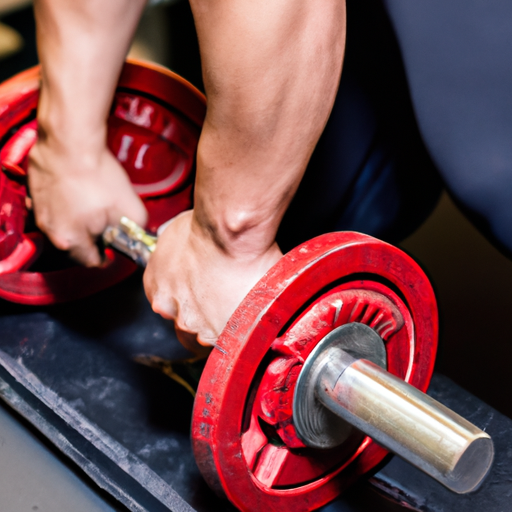If you’re looking to build and tone your muscles, you’ve come to the right place! In this article, we’ll explore different exercises and strategies that can help you achieve your goals. Whether you’re new to strength training or looking to take your workout routine to the next level, we’ve got you covered. Building and toning muscles is not only important for aesthetics but also for overall health and fitness. So, grab your workout gear and get ready to learn some valuable tips and tricks!
Curious to know more? In this article, we’ll delve into the world of strength training and discuss the importance of proper nutrition, the different types of exercises you can incorporate into your routine, and how to avoid common mistakes that can hinder your progress. We’ll provide you with a step-by-step guide on how to gradually increase your strength and tone your muscles effectively. So, if you’re ready to put in the work and see some real results, keep reading and get ready to transform your body!
Understanding Muscle Building and Toning
Definition and Importance of Muscle Building
Muscle building refers to the process of increasing muscle mass through resistance training and proper nutrition. Building muscles not only improves physical appearance but also provides a range of health benefits. Having well-developed muscles can enhance strength, power, and endurance, which are vital for activities such as lifting heavy objects, participating in sports, and maintaining good posture. Additionally, increased muscle mass can boost metabolism, leading to a more efficient calorie burn and aiding in weight management.
Benefits of Muscle Building and Toning
Building and toning muscles offer numerous benefits to individuals of all ages and fitness levels. Some of these benefits include:
-
Increased Strength: Engaging in regular resistance training exercises helps improve muscular strength, making everyday tasks easier to perform and reducing the risk of injury.
-
Enhanced Body Composition: Building muscle and reducing body fat results in a toned and defined physique. Muscles are denser than fat, so even a moderate increase in muscle mass can lead to a more sculpted appearance.
-
Improved Metabolism: Muscle tissue requires more energy to maintain compared to fat tissue. As a result, building muscles can boost metabolism and assist in achieving and maintaining a healthy weight.
-
Protection Against Age-Related Muscle Loss: As individuals age, they naturally experience a decline in muscle mass. By incorporating muscle-building exercises into their routine, individuals can mitigate age-related muscle loss and maintain strength and functionality as they get older.
-
Increased Bone Density: Resistance training stimulates the bones, leading to increased bone density. This is particularly important for women, as they are more prone to osteoporosis.
Factors Influencing Muscle Building and Toning
Several factors can influence the effectiveness of muscle building and toning. These factors include:
-
Genetics: Everyone has a different genetic predisposition for muscle development. Some individuals naturally have an easier time building muscle compared to others.
-
Training Frequency and Intensity: Consistency is key in muscle building. Regularly engaging in resistance training exercises with proper intensity helps stimulate muscle growth.
-
Nutrition: Adequate nutrition is crucial for muscle building. Consuming a balanced diet with sufficient protein, carbohydrates, and healthy fats provides the necessary nutrients to support muscle growth.
-
Recovery and Rest: Muscles grow and repair during periods of rest. Failing to provide adequate rest and recovery can hinder muscle building progress.
Creating an Effective Workout Routine
Setting Goals and Planning
Before starting any workout routine, it’s important to establish clear goals. Do you want to focus on building muscle mass, toning your physique, or achieving a specific strength target? Once your goals are defined, create a plan that outlines the exercises, sets, repetitions, and overall structure of your workouts. Setting realistic short-term and long-term goals can keep you motivated and focused.
Choosing the Right Exercises
When it comes to muscle building and toning, compound exercises are highly effective. These exercises engage multiple muscle groups simultaneously, allowing for efficient muscle growth. Examples of compound exercises include squats, deadlifts, bench presses, and pull-ups. Incorporating a variety of exercises that target different muscle groups ensures balanced muscle development.
Determining the Frequency and Duration of Workouts
The frequency and duration of your workouts will depend on your individual fitness level and goals. Generally, it is recommended to engage in resistance training exercises at least two to three times per week. For muscle building, aim for a higher volume of work by performing multiple sets and repetitions. Allow for sufficient rest between sets to promote muscle recovery and prevent overexertion.

This image is property of pixabay.com.
Proper Nutrition for Muscle Building and Toning
Caloric Intake and Macros
Proper nutrition is essential for muscle building and toning. To build muscle, you need to consume slightly more calories than your body needs for maintenance. This surplus provides the energy required for muscle growth. Additionally, pay attention to your macronutrient intake. Protein is particularly important for muscle building and repair, while carbohydrates provide energy for workouts, and fats support overall health.
The Role of Protein in Muscle Building
Protein plays a crucial role in the muscle building process. It provides the necessary amino acids for muscle repair and growth. Incorporate protein-rich foods into your diet, such as lean meats, fish, eggs, dairy products, legumes, and tofu. Consuming protein shortly after your workout can help maximize muscle recovery and growth.
Importance of Hydration
Maintaining proper hydration is often overlooked but is vital for muscle building and overall health. Water helps transport nutrients to the muscles, aids digestion, regulates body temperature, and lubricates joints. Drink an adequate amount of water throughout the day, especially before, during, and after workouts, to promote optimal muscle function and recovery.
Importance of Rest and Recovery
Understanding the Muscle Repair Process
Muscle growth occurs during periods of rest and recovery, not during workouts. When you engage in resistance training exercises, small tears occur in your muscle fibers. These tears are then repaired during rest periods, leading to muscle growth. Failing to provide adequate rest can impede this repair process and hinder progress.
The Role of Sleep in Muscle Building
Sleep is essential for muscle growth and recovery. During deep sleep stages, the body releases growth hormone, which is vital for muscle repair and growth. Aim for 7-9 hours of quality sleep each night to maximize muscle-building potential.
Incorporating Rest Days into the Routine
Integrating rest days into your workout routine is crucial for preventing overtraining and allowing your muscles to recover fully. Rest days help prevent muscle fatigue, reduce the risk of injury, and allow your central nervous system to recharge. Listen to your body and take rest days when needed to promote long-term success.

This image is property of pixabay.com.
Techniques for Effective Muscle Building
Progressive Overload
Progressive overload is the concept of gradually increasing the demands placed on the muscles over time. This can be achieved by increasing the weight lifted, the number of repetitions, or the intensity of the exercises. Progressive overload challenges the muscles, forcing them to adapt and grow stronger.
Compound Exercises vs. Isolation Exercises
While compound exercises engage multiple muscle groups simultaneously, isolation exercises focus on specific muscles. Both types of exercises have their place in a well-rounded workout routine. Compound exercises are more effective for building overall strength and muscle mass, while isolation exercises are useful for targeting specific muscle groups and addressing muscular imbalances.
Incorporating Resistance Training
Resistance training is a key component of muscle building and toning. Whether using free weights, resistance bands, machines, or bodyweight exercises, resistance training adds stress to the muscles, stimulating growth. Aim for a combination of different resistance training methods to keep your routine engaging and effective.
Supplements for Muscle Building and Toning
Understanding the Role of Supplements
Supplements can be beneficial in supporting muscle building and toning efforts, but they should not replace a balanced diet. They are meant to complement a healthy lifestyle and proper nutrition. Supplements can include protein powders, branched-chain amino acids (BCAAs), creatine, and multivitamins.
Popular Supplements for Muscle Building
Protein powders are commonly used to supplement protein intake and support muscle repair and growth. BCAAs are often consumed during or after workouts to promote muscle recovery. Creatine is a popular supplement that can enhance muscle strength and power. Consult with a healthcare professional or a registered dietitian before incorporating any supplements into your routine to ensure safety and effectiveness.
Consulting with a Professional
If you’re new to muscle building or have specific goals, it can be beneficial to consult with a personal trainer or strength and conditioning specialist. They can assess your current fitness level, help design a personalized workout routine, and provide guidance on proper form and technique.

This image is property of pixabay.com.
Avoiding Common Mistakes and Injuries
Improper Form and Technique
Performing exercises with improper form and technique can lead to injuries and limit the effectiveness of your workouts. When starting a new exercise, seek guidance from a professional or watch instructional videos to ensure proper form. Focus on mastering the technique before increasing weight or intensity.
Overtraining and Burnout
Overtraining occurs when you exceed your body’s ability to recover between workouts. This can lead to physical and mental burnout, increased risk of injury, and hindered progress. Pay attention to your body’s signals and incorporate rest days into your routine.
Importance of Warm-up and Stretching
Performing a proper warm-up before each workout can help prevent injuries and improve performance. Warm-up exercises increase blood flow to the muscles, prepare the joints for movement, and mentally prepare you for the upcoming workout. Similarly, incorporating stretching exercises at the end of your routine can enhance flexibility and reduce muscle soreness.
Tracking Progress and Adapting the Routine
Keeping a Workout Journal
Keeping a workout journal allows you to track your progress over time. Include details such as exercises performed, weights used, number of sets and repetitions, and any notes or observations. This record can help identify areas of improvement and allow for adjustments to your routine.
Measuring Strength and Muscle Growth
In addition to tracking workouts, periodic strength and body measurements can help gauge progress. Use tools such as weight scales, body circumference measurements, and body fat calipers to monitor changes in muscle mass and body composition.
Modifying the Routine for Plateaus
As you become more advanced, it’s common to experience plateaus in muscle building progress. To overcome plateaus, incorporate variations into your routine, such as changing exercise order, adjusting weights and repetitions, or trying new exercises altogether. Shocking the muscles with different challenges can reignite growth and progress.

Staying Motivated and Consistent
Finding What Inspires You
Finding what inspires and motivates you is crucial for long-term success in muscle building and toning. Set specific goals, visualize your progress, and surround yourself with positive influences to stay on track. Whether it’s fitting into a certain outfit, achieving a strength milestone, or simply feeling confident and healthy, find what drives you and keep it in mind throughout your fitness journey.
Creating a Supportive Environment
Having a supportive environment can significantly impact your motivation and consistency. Surround yourself with like-minded individuals who share similar goals or join fitness communities online. Having a workout buddy can also make exercising more enjoyable and hold you accountable.
Pacing Yourself for Long-Term Success
Muscle building and toning are long-term processes. Avoid the temptation of rushing progress or comparing yourself to others. Embrace a sustainable pace that allows for continuous improvement and minimizes the risk of burnout. Stay patient and trust the process, and you’ll build and tone your muscles effectively over time.
Conclusion
Building and toning muscles requires a combination of proper nutrition, effective workouts, adequate rest and recovery, and consistency. By understanding the principles and techniques of muscle building, as well as avoiding common mistakes and injuries, you can develop a well-rounded workout routine tailored to your goals. Take the necessary steps to fuel your body with the right nutrients, provide ample rest and recovery, and stay motivated throughout your fitness journey. With dedication and patience, you can achieve the muscle development and toning you desire.


